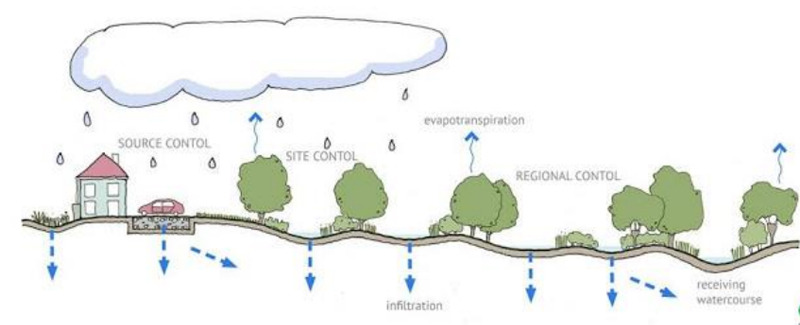- Mitigation title
- Sustainable urban drainage systems (SuDS)
-

- Description
-
Sustainable drainage systems can be of any size and of variable function and are used to effectively manage effluent. It is made up of constructed features that mimic natural drainage processes. For example, natural features such as wetlands, trees, swales, green roofs or man-made features such as permeable pavements, soakaways, etc. The main aim is to intercept and improve infiltration/percolation of surface water run-off so as to improve water quality.
In Herefordshire, the Hereford livestock market near Stretton Sugwas has a SuDS that treats all the wash-down water from the yards to a re-usable quality.
Constructed wetlands within a SuDS design have the highest evidence for phosphate removal. Although the levels of phosphate runoff from a single site is often too low to provide a source for phosphate mitigation.
- Advantages
-
Dependent on system used but:
- Biodiversity enhancement
- Carbon sequestration
- Flood mitigation
- Disadvantages
-
- Scale is constrained by the urban environment
- Parameters
-
- Phosphorus
- Nitrogen
- Sediments
- Heavy metals
- Carbon footprint
-
- Short term energy requirements for earth works
- Potential release of carbon or methane from soils
- Potential sequestration benefits but only from vegetation-based SuDS
- Time to become effective
-
- Immediately upon installation
- Maintenance
-
- Maintenance to prevent blockages from excess fine sediment:
- Monthly for debris removal
- Half yearly grass cutting
- Annual vegetation management
- Maintenance to prevent blockages from excess fine sediment:
- Performance with time
-
- Performance can be kept at optimum with well a well-established maintenance schedule
- Scaling considerations
-
SuDS are constrained by the urban environment so building an appropriate scale system may not always be possible. Considerations to be taken:
- Land availability
- Mass loading and population equivalent to be evidenced as well as the hydraulic characteristics of the site
- Must take into account climate factors and climate change, such as droughts and dry weather, or water gains from rainfall, etc. as well seasonal dynamics and differences in flows through different seasons
- Must take into account seasonal efficiency tied to plant growth and appropriate plant species, if using SuDS with vegetation
- References
-
British Geological Survey. (n.d.). Sustainable drainage systems (SuDS). Retrieved from https://www.bgs.ac.uk/geology-projects/suds/
Forest Research. (n.d.). Sustainable urban drainage systems (SUDS). Retrieved from https://www.forestresearch.gov.uk/tools-and-resources/fthr/urban-regeneration-and-greenspace-partnership/greenspace-in-practice/benefits-of-greenspace/sustainable-urban-drainage-systems-suds/
Herefordshire Council. (n.d.). Sustainable Drainage Systems Handbook. Retrieved from https://www.herefordshire.gov.uk/downloads/download/1863/sustainable_drainage_systems_handbook
Ricardo for Herefordshire Council. (2021). Interim Phosphate Delivery Plan Stage 2, Mitigation options for phosphate removal in the Wye Catchment.
